How Mars Loses Water - A Simulated Scientific Study

When summer comes in the southern hemisphere of Mars, a “window” opens in its atmosphere, through which water vapor can rise from the lower layers of the gas envelope of the planet to the upper ones.
Most of this water vapor is carried by the winds to the north pole of Mars, where it is deposited on the surface in the form of ice, but a certain amount of water vapor still disintegrates and disappears into open space, gradually depriving the red planet of water reserves.
')

A group of scientists (Dmitry Shaposhnikov, Alexander Medvedev, Alexander Rodin and Paul Hartog) from the Moscow Institute of Physics and Technology (Moscow Institute of Physics and Technology, Russia), the Space Research Institute of the Russian Academy of Sciences (Russia) and the Institute of Solar System Studies named after Max Planck (Germany) described this unusual Martian whirlpool and the release of water vapor into space in her research, presented in the journal Geophysical Research Letters .
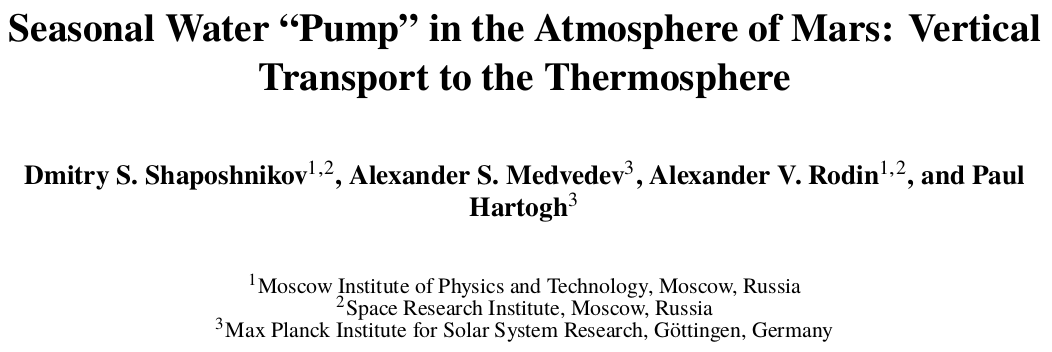
According to scientists, many millions of years ago, Mars was rich in oceans, seas and other sources of water. However, during all this long time in the upper atmosphere of Mars a kind of natural “pump” worked, with the help of which the dehydration of the red planet took place. Today, approximately 20% of the water structure of the initial amount remains on the surface of the planet.
In their study, scientists reconstructed the model of water loss by Mars and determined that this mechanism is still working, and its functionality is similar to a pump. Computer simulation of this mechanism shows how water vapor overcomes the cold air barrier in the middle atmosphere of Mars and reaches higher layers. This, according to the authors of scientific work, will help to understand why Mars, unlike Earth, has lost most of its water.
Brief description of the study
Millions of years ago, Mars was a planet with a vast water surface, rivers flowed on it, and even oceans raged. But time passed, and the natural mechanism on the planet gradually reduced water reserves, greatly changing the surface of Mars beyond recognition.
Today on the surface of Mars you can find very few areas with frozen water, and in the atmosphere water vapor is found only in trace amounts. Thus, Mars may have currently lost at least 80 percent of its water supply.
The reason for this global, and at the same time, long-term water loss is that in the upper atmosphere of Mars solar ultraviolet radiation splits water molecules into hydrogen (H) and hydroxyl radicals (OH). And after this process, the irrevocable volatilization of hydrogen into space.
Measurements using research probes on the orbit of Mars and space telescopes show that even at present, water vapor on Mars continues to split and leave the planet in this way.
But how and why did this become possible?
After all, the middle layer of the atmosphere of Mars, by analogy with the tropopause on Earth, should practically block such a runaway of hydrogen, because at the height of this layer it is usually already so cold that water vapor turns into ice.
To get an answer to this question, Russian and German researchers conducted a simulation that revealed a previously unknown mechanism resembling a pump.
In their simulation, flows in the entire atmosphere enveloping Mars are comprehensively described: from the surface of the planet to layers at an altitude of 160 kilometers.
Calculations show that the ice middle layer of the gas envelope becomes permeable to water vapor twice a day, but only in a certain place of the planet and at a certain time of the year (at a certain point of the orbit).
The orbit of Mars plays a crucial role in this process: the path of the planet around the Sun, which lasts about two Earth years, is much more elliptical than that of the Earth.
At the point closest to the Sun (approximately coincides with summer in the southern hemisphere) Mars is approximately 42 million kilometers closer to it than at the farthest point of the orbit, therefore summer in the southern hemisphere is noticeably warmer than in the northern.

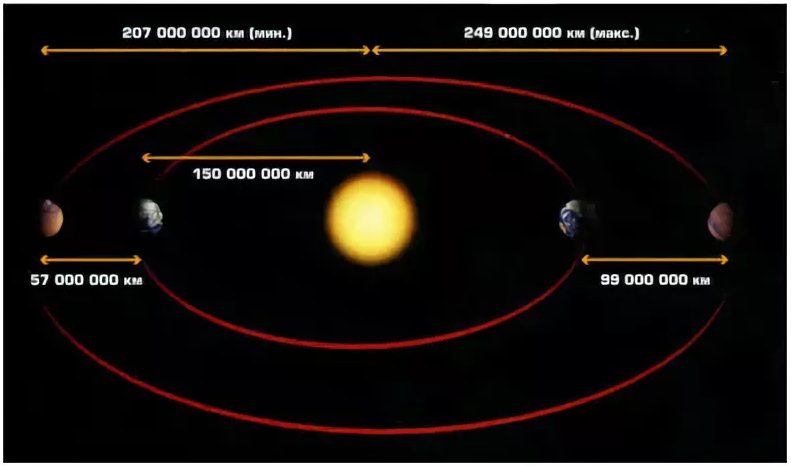

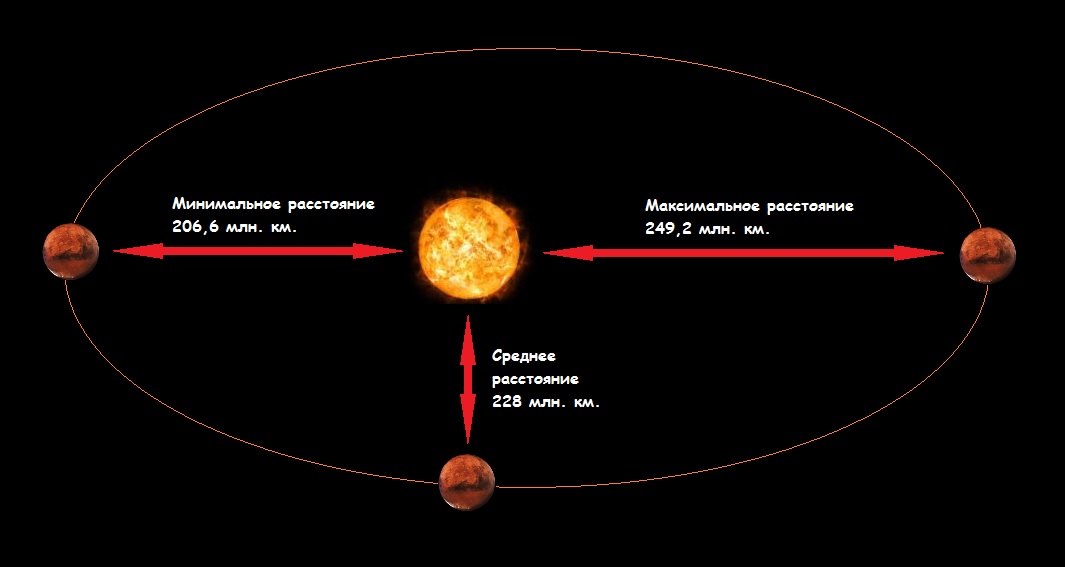
When summer arrives in the southern hemisphere of Mars, water vapor can rise locally with warmer air masses at certain times of the day and reach the upper layers of the atmosphere.
There the air flows carry gas to the north pole, where it cools again and settles. However, part of the water vapor is excluded from this cycle: under the influence of solar radiation, water molecules disintegrate, and hydrogen escapes into space.
This unusual hydrological cycle is enhanced by another feature of Mars - huge dust storms that cover the whole of Mars with an interval of several years.
The gigantic amount of dust circulating in the atmosphere during such a storm facilitates the transport of water vapor to the upper atmosphere.
The last time such dust storms occurred on Mars in 2007 and 2018, they were also fully documented by orbital probes.
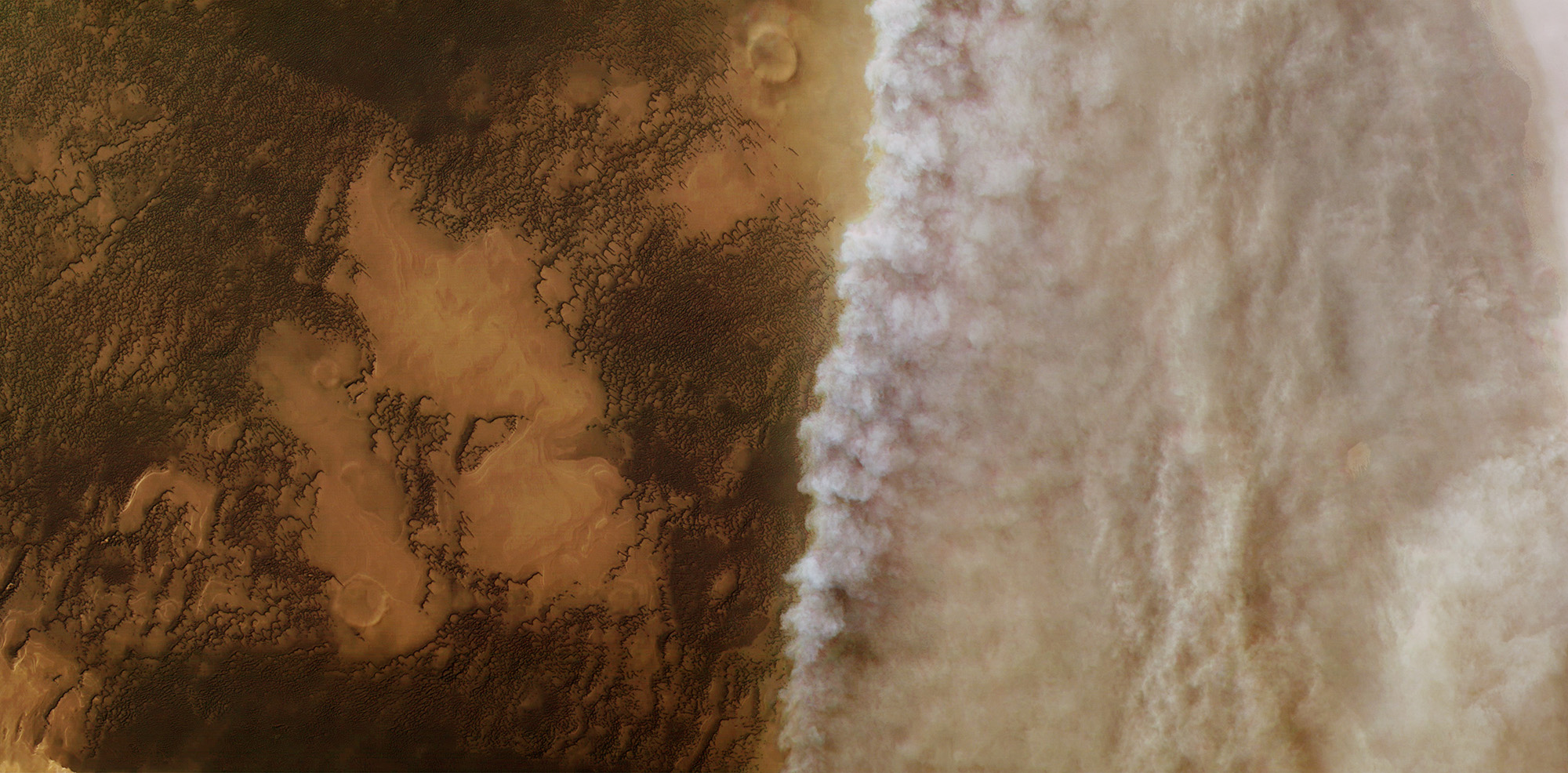
Scientists estimate that during the 2007 dust storm, twice as much water vapor fell into the upper atmosphere of Mars than it does in calm times for the planet.
As the dust particles absorb sunlight and, thus, they are heated, the temperature of the atmosphere on Mars rises.
Received by scientists from MIPT and the Institute. The Max Planck model with unprecedented accuracy shows how dust in the atmosphere affects the microphysical processes associated with the transformation of ice into water vapor.
Graphs and applications for research work:
Figure 1. Vertical water vapor flow

Figure 1. Seasonal variations in latitudes of a zonal averaged vertical flow of water vapor modeled using averaged data on the amount of dust in the atmosphere at different altitudes: 0, 30, 60, 90, 120 and 150 km. Positive values (ascending flows) are shown in red, negative (descending) flows are shown in blue.



Thus, we will be interested in the data, mainly in the interval between Ls = 250◦ and 270.
Escape of hydrogen atoms into the space varies by an order of
magnitude seasonally maximizing around summer summer solstice (solar longitude Ls ≈
270◦)
The designations in Figure 1 and Figures below:
ppmv (parts per million by volume) is a unit of concentration in ppm by volume;
Water vapor - water vapor;
Altitude - height above sea level;
Latitude - latitude;
Ls - solar longitude;
MY28 - Martian Year 28 (measurements during the 28th Martian year);
Basic dust scenario (“main” dust scenario) - averaged data on the amount of dust in the atmosphere were used (based on data from the Mars probe MAVEN (Mars Atmosphere and Volatile Evolution), automatic observatory Hubble, satellite Mars Reconnaissance Orbiter (MRO) - from the instrument Mars Climate Sounder (MCS), PFS - MEX (Planetary Fourier Spectrometer on board Mars Express), Mars Global Surveyor;
Dust storm (dust storm) - used data on the amount of dust in the atmosphere in dust storm MY28.
Figure 2. Concentration and temperature of water vapor
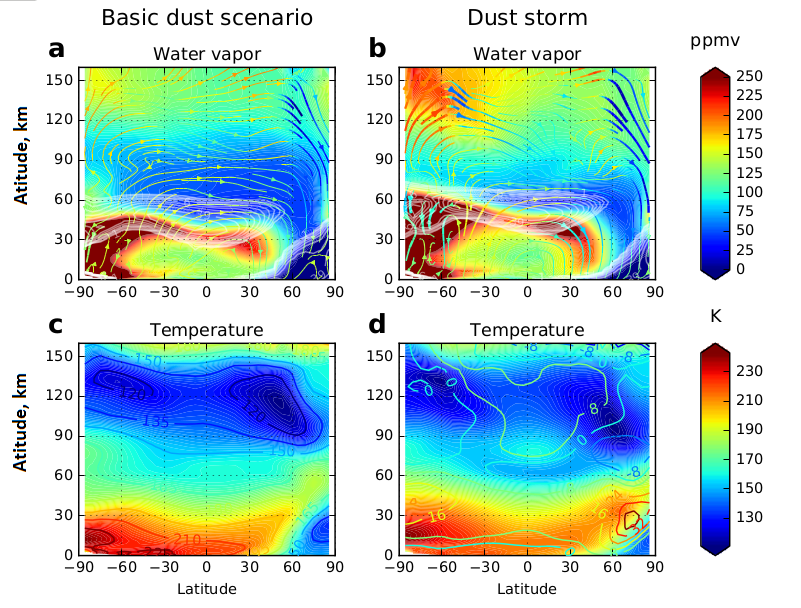
Figure 2. Concentration and temperature of water vapor in height and latitude, modeled using average data on the amount of dust in the atmosphere (graphs in the column on the left) and in the year of the dust storm MY28 (graphs in the column on the right), all fields are averaged over the zones and for the period between Ls = 250◦ and 270◦, where:
a) water vapor (dark contours), water ice (white contours) and meridional water vapor flow (lines with arrows, the color and thickness of which indicate the vertical direction and ppmv value, respectively);

(b) the same as in (a), but for a dust storm during MY28;
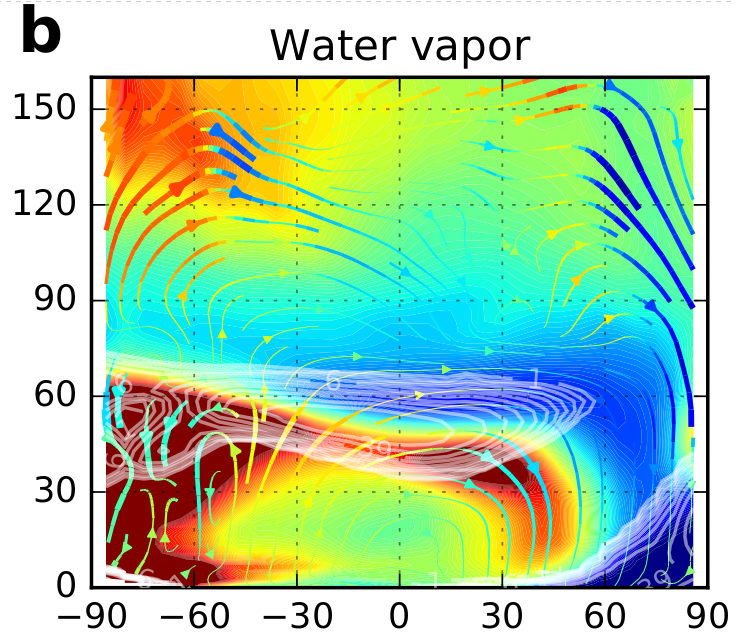
(c) a graph with the temperature of the water flow for the “main” dust scenario;
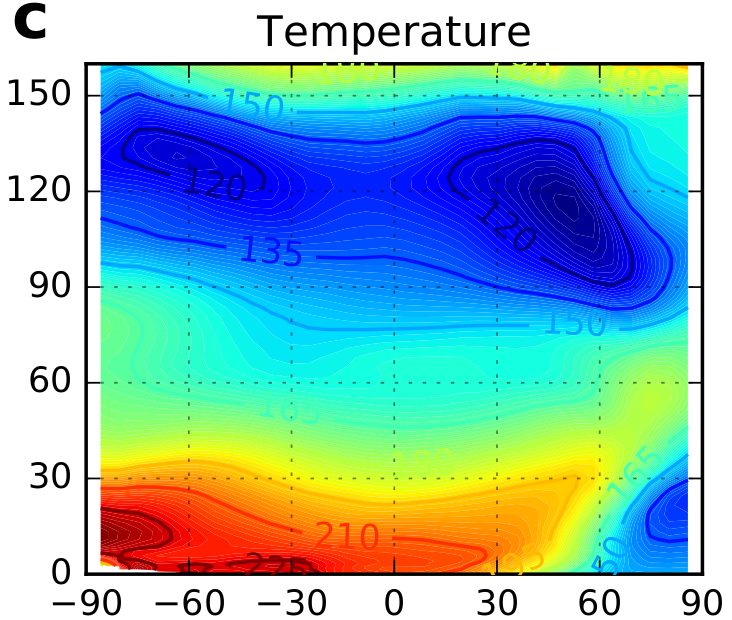
(d) the same as in (c), but for the dust storm scenario during MY28, except for the contour lines that show the temperature difference between (d) and (c).

It can be seen that during storms the concentration of water vapor in the upper layers is higher, and their temperature is higher.
Figure 3. The concentration of water vapor at different altitudes and at different times of the Martian day.
Sol is a Martian day. They are slightly longer than the earth and are 24 hours, 39 minutes, 35.244 seconds. The year on Mars is equal to 669.56 “salts” or 686.94 Earth days.

Figure 3. Altitude-time distribution of deviations from the mean value for water vapor concentration (color shades ppmv) and vertical speed (on contours, values in m / s), according to data for the period between Ls = 250◦ and 270◦ (measurement coordinates are Lat 75S. Lon 0).
Positive vertical speeds correspond to upward movements.
(a) the “main” dust scenario:

(b) the same as in (a), but for a dust storm during MY28:

As can be seen, on the second graph in the upper layers there are more windows with a high concentration of water vapor with a positive vertical velocity, which form upward streams further into outer space.
Figure 4. Annual water cycle.

Figure 4. Vertical distribution of total water content (steam + ice) obtained:
(a) and (c) - day and night according to the Mars Climate Sounder (MCS), which is installed on the Mars Reconnaissance Orbiter (MRO);
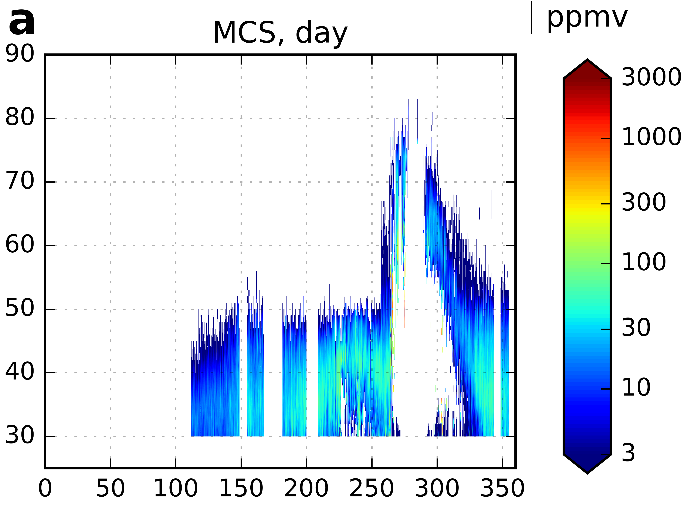

(b) and (d) - day and night according to data from the simulation in the study.


In the graphs in Figure 4 above:
- in the afternoon - this is according to the data at 15:00 of the day, according to the Martian time;
- at night - this is according to the data at 03:00 am Martian time.
In all graphs of Figure 4, the values for longitude and latitude were averaged.
During data processing, the simulation was performed by averaging over local times in the periods of 14: 00–16: 00 and 02: 00–04: 00.
In the conclusion of their research, the authors summarize that the atmosphere of Mars is more permeable to water vapor than that of the Earth, and the opened seasonal water cycle largely contributes to the continued functioning of the natural mechanism of water vapor loss by Mars.
Source: https://habr.com/ru/post/451412/
All Articles